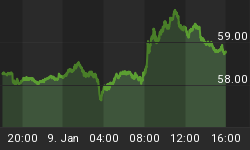Between 1966 and 1982 the Dow Industrials Index essentially traded sideways within a wide range. Therefore, a long-term chart of the Dow unadjusted for the effects of inflation will not reflect the fact that in real terms the bear market of the 1970s was every bit as severe as the bear market of 1929-1932. The reason, of course, is that the enormous wealth destruction that occurred within the US stock market during the 1970s was masked by inflation, that is, by a substantial reduction in the value of the US$. This is why it is critical to account for the effects of inflation when attempting to ascertain the secular trend in any market.
In our opinion, by far the best way to account for the effects of inflation when taking a very long-term view is to express prices in terms of gold ounces. The reason is that regardless of the attempts to manipulate the gold price that have always occurred and always will occur, when the market's confidence in the ability of a government to maintain the purchasing power of its currency begins to fall the gold price, in terms of that currency, ALWAYS begins to rise within a reasonable space of time to reflect the diminishing confidence.
Further to the above, we think the secular trend in the US stock market only becomes clear when the performance of the market is measured in terms of gold. We therefore define a secular bull market in US stocks as an upward trend in the Dow/gold ratio lasting 10-25 years and a secular bear market as a similarly lengthy downward trend in the Dow/gold ratio.
Below is a long-term chart of the Dow/gold ratio and this chart, we think, shows quite clearly that a secular peak was put in place a few years ago. The implication is that we are now a few years into a secular bear market that will last at least 10 years and take the Dow/gold ratio back to near the bottom of its long-term channel. In fact, the chart suggests that the bulk of the downside in the Dow relative to gold is yet to come. This does not, of course, mean that the Dow will experience a large decline in nominal dollar terms, although the most likely way for the secular trend to reach its ultimate target would be via weakness in the Dow alongside strength in gold.

The Intermediate-Term Trend
In terms of gold the direction of the US stock market's long-term trend is clearly down, but the direction of the intermediate-term trend is not so clear. The below chart, for example, shows that the S&P500/gold ratio has been oscillating within a fairly narrow range since July of 2003. Despite the current closeness of the ratio to the top of its 18-month range we expect that this sideways trading will end via a downside breakout at some point over the next several months, but note that an upside breakout from this drawn-out trading range would not alter the big picture; it would simply indicate that the rebound from the Q1-2003 low was not yet complete.
















